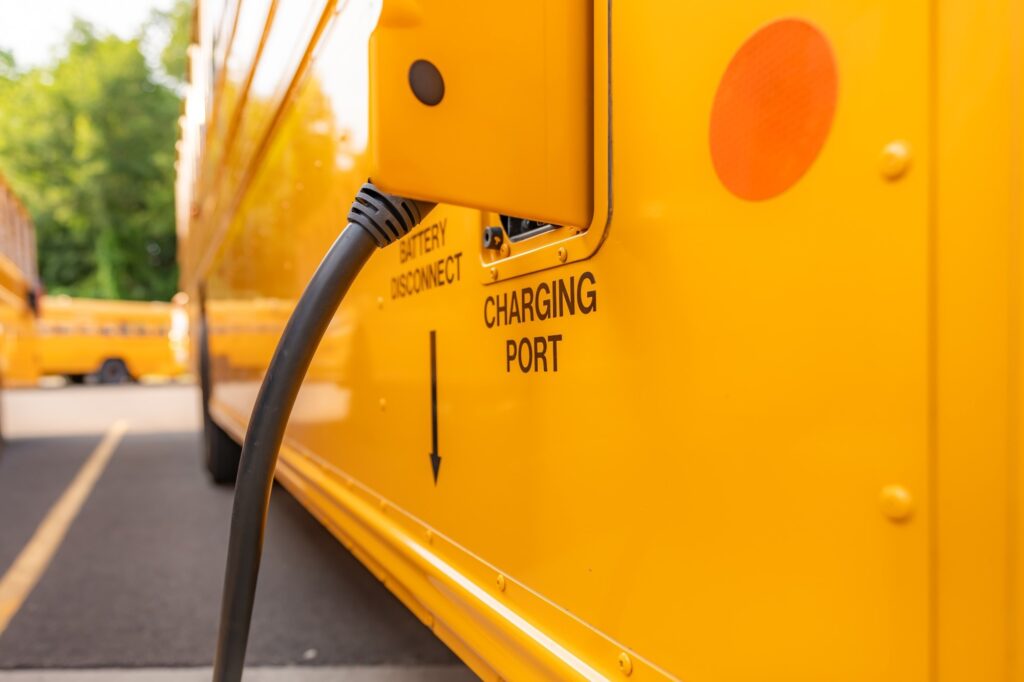In a study recently published in PNAS, researchers evaluate the health and climate benefits of replacing old diesel school buses with electric buses in the United States.

Study: Electric school bus adoption in the United States: Health and climate benefits. Image credit: SEALANDSKYPHOTO / Shutterstock.com
Environmental impact of diesel buses
The transportation sector is the largest contributor to greenhouse gas (GHG) emissions and associated air pollution in the U.S. Recent estimates suggest that vehicle emissions are responsible for approximately 20,000 deaths each year in the U.S., with 90% of those deaths attributable to exposure to 2.5-micron fine particulate matter (PM2.5) in the air.
Approximately 500,000 school buses serve approximately 24 million students in the U.S. A significant percentage of these buses are 2005 model diesel vehicles, which are estimated to emit 12 times more PM2.5 per mile traveled than 2010 model diesel school buses.
Electric vehicles are considered a promising alternative to diesel vehicles in reducing the health and environmental impacts of transportation globally. According to one estimate for 2023, there are currently 2,277 electric school buses in circulation in the United States, accounting for just 0.5% of the national school bus fleet.
A study analyzing vehicle, fuel, maintenance, and insurance costs shows that without subsidies, the total cost of purchasing an electric bus would be approximately $156,000 more than a diesel bus. Given these high costs, it is essential to evaluate the health and environmental benefits of electric vehicles to inform policy decisions regarding replacing older diesel school buses with electric buses.
About the Research
In the current study, the scientists estimated the benefits per mile of replacing diesel school buses with electric buses in 3,108 counties in the United States.
The average number of vehicles in each county in 2017 was considered, as well as four alternative vehicle types, including diesel buses from model years 2005, 2010 and 2020. The health benefits of electric school buses were determined by estimating adult mortality and new asthma cases in children and adolescents from chronic exposure to airborne PM2.5.
Important Observations
Considering an average diesel school bus fleet in 2017, replacing it with an electric bus is estimated to generate health and climate benefits of $43,800 and $40,400, respectively, due to reduced greenhouse gas emissions. The health benefits are associated with reduced PM2.5-attributable mortality and new cases of childhood asthma, with economic values of $40,000 and $3,700, respectively.
The entire diesel school bus fleet was associated with 170 deaths and 280 new cases of childhood asthma due to exposure to PM2.5 in 2017. By comparison, researchers estimate that completely replacing diesel buses with electric buses would result in seven deaths and 12 new cases of childhood asthma due to exposure to PM2.5.
 (A) Health benefits of electrifying the average diesel school bus fleet in 2017, by trip location and outcome. (B) Health impacts for the school bus fleet, by trip location and pollutant type, in 2017. Locations are categorized using the NCHS urban-rural classification. DSB: diesel school bus. ESB: electric school bus.
(A) Health benefits of electrifying the average diesel school bus fleet in 2017, by trip location and outcome. (B) Health impacts for the school bus fleet, by trip location and pollutant type, in 2017. Locations are categorized using the NCHS urban-rural classification. DSB: diesel school bus. ESB: electric school bus.
The health benefits of electric buses vary significantly depending on the year of replacement of diesel buses and the operating location. Replacing diesel buses in more densely populated areas had greater health benefits. An analysis breaking down counties by degree of urbanization found that the health benefits of electric buses varied from USD 85,800 in metropolitan center counties to USD 16,800 in rural counties.
Taking into account vehicle model, replacing a 2005 model diesel bus with an electric bus has seven times the health benefits compared to replacing it with a 2010 model diesel bus and 16 to 18 times the health benefits compared to replacing it with a 2020 model diesel bus. Additionally, replacing a 2005 model diesel bus operating in a metropolitan center with an electric bus provides health benefits of USD 207,200.

Health benefits of electric school buses in each county if each county's average diesel school bus was replaced with an electric school bus in 2017. Values below $10,000 are not shown (n = 448 counties). This includes three counties with negative benefits ranging from -$300 to -$800. County geographic boundaries are taken from the U.S. Census Bureau.
Significance of the study
Replacing older diesel school buses with electric buses, especially in densely populated areas, is predicted to have significant health benefits, including reducing mortality and new cases of childhood asthma associated with exposure to airborne PM2.5. However, replacing newer diesel buses with electric buses in less densely populated areas may have more modest health benefits.
An electric school bus is $156,000 more expensive than a new diesel school bus over its lifespan. However, the health benefits of electric buses are associated with an economic value of more than $200,000 per bus, demonstrating the cost-effectiveness of replacing diesel school buses with electric school buses.
This study did not evaluate the extent to which electric buses reduce children's exposure to interior air pollution while riding on the bus. Evaluation of this additional health benefit is particularly important for policy decisions regarding the introduction of electric school buses in rural areas where the health benefits associated with ambient PM2.5 exposure may be insufficient to make the introduction of electric school buses cost-effective.



